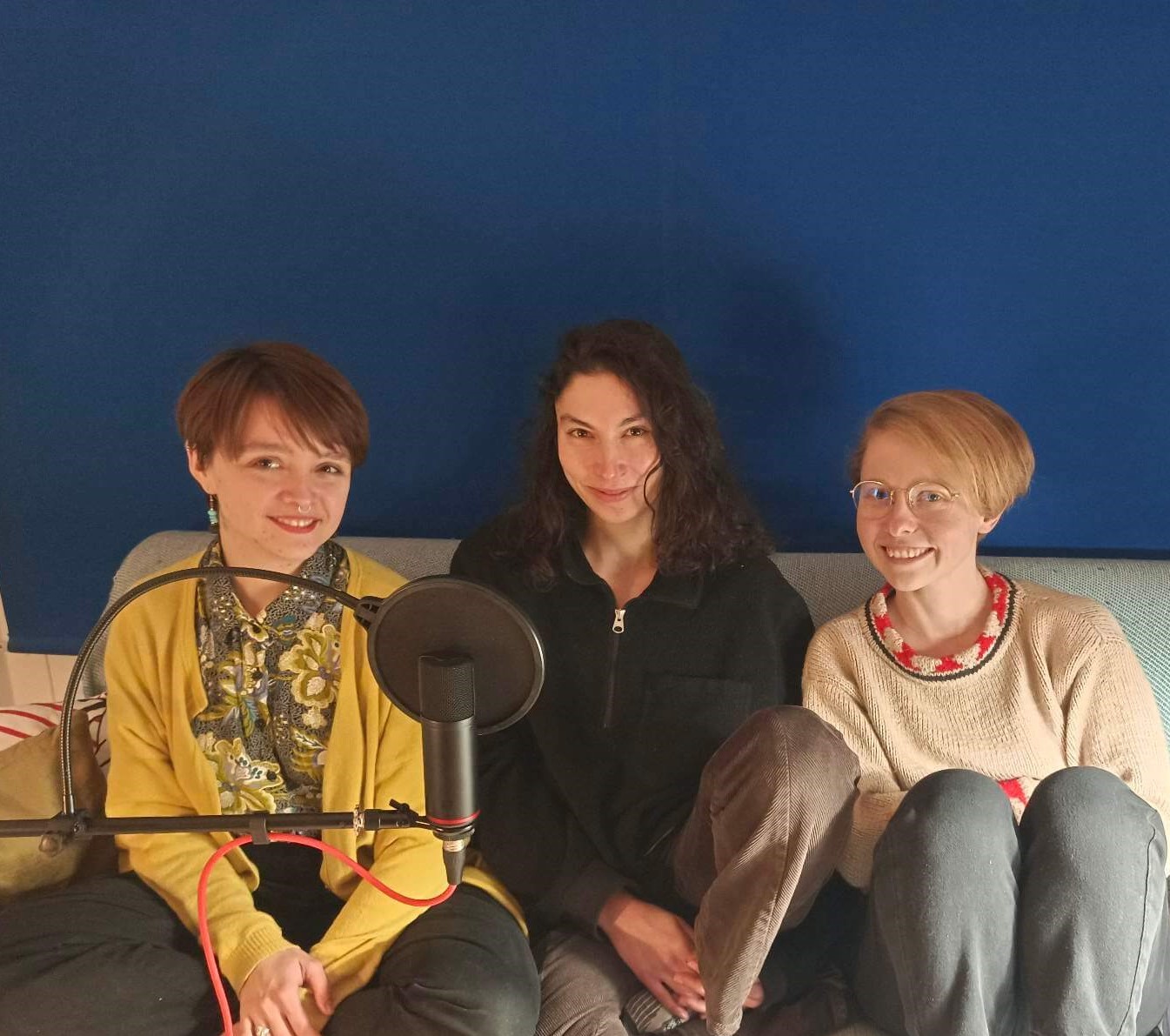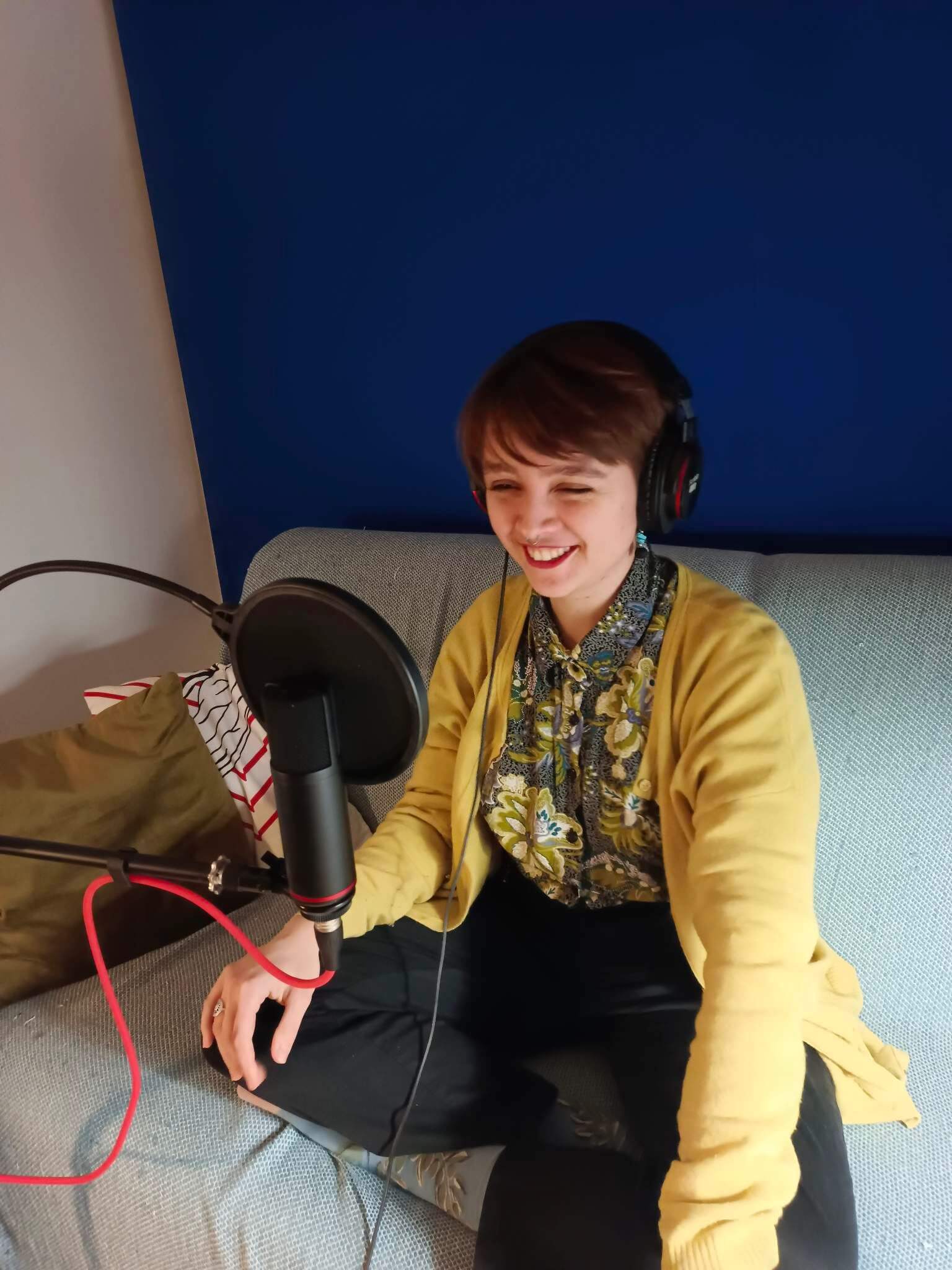Step by step, opening up the project to the a larger audience¶
Step 1 : Virtual talk, creation of a punctual podcast : Perspectives Textiles¶
Context: L'Ecole de l'Anthropocène
The idea of this podcast creation happened prior to the Week of the Anthropocene.
This event, occuring from January the 24th to January the 28th of 2023, is launched by the Urban School of Lyon/University of Lyon, in partnership with Le Rize, le LabEx IMU (Intelligences des Mondes Urbains) and Cité anthropocène. It is also a collaboration with October Octopus.
The goal of it is to understand, imagine and build possiblities around global change.
The program is composed of a mix of debates and conferences with huge witnesses of global change, workshops, seminaries, urban walks... and a radio set!
)
Radio Anthropocène is the first global radio that tackles the plurality of issues at stake during the Anthropocene.
Perspectives textiles : the podcast

The idea, imagined by Marion Banon, was to interview Amandine, herself and I about a topic linked to our project, in order to introduce other ways of thinking in the field of textile. The chronique was a 3/4 minutes one, and three chroniques were to be made with our three speeches. We chose a formula of monolog, in order to share the maximum information, without overlooking the fact that we were transmitting this information to listeners who weren't necessarily familiar with our subjects.
Amandine shared her discoveries on mycellium, introducing this fantastic material through the display of all of its potentialities, not only in the field of textile, but also in food, care, etc.
Marion addressed the topic of modularity in fashion and textile to bring to the table that another way of producing clothes is possible.
For my part, I talked about the use of dog hairs and human hair in the field of textile, but not only, adding the idea that we, as individuals, can think of fiber waste in another way.
Here is my french script


Bonjour!
Aujourd’hui, dans le cadre de cette chronique sur les nouvelles perspectives du textile, je vous propose de changer de point de vue sur deux déchets du quotidien pour découvrir des ressources méconnues : et si je vous disais que l’une de ces ressources se trouve sur votre tête, et l’autre, sur le dos de votre chien?
Je m’appelle Laora Guillerm, et aujourd’hui, j’ai envie de vous évoquer sous un autre jour deux fibres que vous connaissez tous et toutes: vous l’aurez deviné : je parle bien sûr des poils de chien et des cheveux.
Mmh..Commençons par évoquer les poils de chien; ces poils qui finissent bien souvent à la poubelle…et pourtant! Il est possible de vous tricoter un pull chaud et confortable aux couleurs de votre compagnon à quatre pattes. De nombreuses races de chiens possèdent un poil doux et suffisamment long pour en faire des pelotes de laine.
Ce qu’il faut savoir, c’est que la fourrure d’un chien est constitué de deux types de poils: les poils de couverture, et le sous-poil. C’est ce sous-poil qui s’avère le plus efficace dans la mise en forme de laine de chien. En France par exemple, l’entreprise artisanale Canislana, se propose de vous confectionner des pelotes à partir des poils brossés de votre chien ou de votre chat! En tant qu’amoureuse des chiens, cela me ravit!
Et pour revaloriser ces fibres à plus grande échelle me demanderez-vous? C’est possible aussi! En effet, après avoir fait le constat que chaque année, plus de 1000 tonnes de sous-poil fin et peigné de chiens ou de chats sont jetés après toilettage, la marque de mode allemande Modus Intarsia, créée par Ann Catrin Schonrock et Franziska Uhl, a développé et produit des fils de haute qualité à partir des poils de chien collectés dans toute l’Allemagne. Cette laine, brevetée sous les noms de Chiengora et de Chiencell, est très douce et s’apparente à du mohair, du cachemire ou de l’angora! Etonnant n’est-ce pas ?
Et… vos cheveux après tout? Ce sont des poils aussi! En France, on estime que 3 à 4000 tonnes **de cheveux sont jetés chaque année. Plutôt que de joncher le sol de votre salon de coiffure, ne pourraient-ils pas servir à une cause plus grande, comme celle de filtrer et dépolluer les eaux, en villes ou dans l’océan ?
Eh oui! Les cheveux, eux-aussi, sont incroyables! Imputrescibles, ainsi que lipophiles et hydrophiles: ils ne pourrissent pas, et absorbent le gras et l’eau. Savez-vous que les cheveux peuvent absorber de 3 à 8 fois leur poids en hydrocarbures? Depuis 2000, l’organisation caritative américaine Matter Of Trust expérimente avec succès des boudins de cheveux bio-absorbants, qui ont notamment été utilisés lors de la marée noire de 2010, dans le Golfe du Mexique. Des tapis bio-absorbants de cheveux, poils d’animaux de compagnie et de toison de mouton sont aussi produits dans cette même optique de dépollution.
En France, l’entreprise Capillum, première filière de recyclage de cheveux sur le sol français, a créé un réseau de coiffeurs partenaires auprès desquels se faire coiffer pour donner ses cheveux. On en trouve plus d’une quarantaine dans Lyon et ses environs!
Alors, vous aussi, en brossant votre animal de compagnie, ou en allant faire rafraichir votre coupe, vous pouvez contribuer à la revalorisation de ces fibres devenues ressources ! Ou comment devenir acteur du textile avec des actions simples!
Here you can listen to the podcast!
Here is Amandine Féry's intervention
Here is Marion Banon's intervention
And the final word is given to...Judex, Marion's cat! Yes, you darling, can give your hairs to help depolluting waters!

Meeting with people in a street context : Street interviews¶
With Amandine Féry, we realised that both our projects were about sharing about innovative or unusual materials.
We decided to start a little local prospection in Lyon's streets. We were posted in Bellecour, one of the main squares of Lyon.
We asked several questions to random people, trying to target different ages.
The questions
About dog wool and dog hairs :
- What image or feelings do you have when I tell you that dog wool can be produced out of dog hairs?
- Would you feel at ease wearing a scarf or a pullover made with dog wool?
- Do you think that dog wool could be a great alternative to sheep wool, even at a smaller scale?
- Does this fiber disturb you? If yes, why?
About human hair :
- What do you think of giving your own hair for an environmental cause? Would you have interest in giving your hair? Have you already heard about this before?
- Does the touching of cut human hair disgust you? What are the sensations that come with it? Why?
Tao, 22 years old
This young man was not disgusted by the hair and dog hairs pebbles.
He would be willing to give his hair to an organization like Matter of Trust or Capillum.
When talking about the use of dog hairs in the industry of textile, he put the highlight on the fact that he was against harming dogs.
When asking if he thought it could be an alternative to the sheep wool, he said that the idea of farming sheeps sounded different to him, since they are supposed to be farmed to produce both wool and meat. To him, there is a more important emotional bond between the dog and the human being.
He had already heard about the process of spinning dog hairs.
Also, he was dubious of the fact that hair could help depollute waters at a huge scale, but he thought that it was a good way to implicate people in the process.
Kelian, 20 & Alexis, 21
They haven't heard about the use of dog hairs in textile. They were ok for the use in the domestic field, but not at an industrial scale. They weren't shocked or disgusted by the principle.
Both of them were ok to give their hair to an organization.
They weren't having a different feeling when holding both human hair and dog hairs pebbles.
"It looks like a doormat.", Alexis.
Priscille, 48
This woman was walking her dog.
She already knew about the existence of dog wool and was sensible to it. Nonetheless, she told us that she had never tried to send her dog's hairs to a craftman ; she said "Maybe I have to be carried by the hand."
She was ok for this, but not with her own dog's hairs.
Also, she wasn't ok to do knit something by herself.
She advised me to sensitize dog owners. However, she wans't feeling at ease to wear dog wool.
About dog hairs, she was disgusted by it. She mentioned that it made her think about the hair history, especially concerning concentration camp.
She had also already heard about bio-absorbing hair.
Then, it was time to start attending workshops. Confronting my project to other people !!
Communicating through social medias¶
This was a huge challenge for me, since I am not used to communicate via social medias.
It took me a long time to make a pleasing visual communication, but I get to this point after several attempts.
Here are some information regarding the graphic charter and choice of social media communication I made.